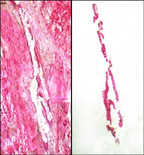
Photo from wikipedia
BackgroundGene expression changes that govern essential biological processes can occur at the cell-specific level. To gain insight into such events, laser microdissection is applied to cut out specific cells or… Click to show full abstract
BackgroundGene expression changes that govern essential biological processes can occur at the cell-specific level. To gain insight into such events, laser microdissection is applied to cut out specific cells or tissues from which RNA for gene expression analysis is isolated. However, the preparation of plant tissue sections for laser microdissection and subsequent RNA isolation usually involves fixation and embedding, processes that are often time-consuming and can lower the yield and quality of isolated RNA.ResultsInfection sites of the parasitic plant Cuscuta reflexa growing on its compatible host plant Pelargonium zonale were sectioned using a vibratome and dried on glass slides at 4 °C before laser microdissection. High quality RNA (RQI > 7) was isolated from 1 mm2, 3 mm2 and 6 mm2 total surface areas of laser microdissection-harvested C. reflexa tissue, with the yield of RNA correlating to the amount of collected material (on average 7 ng total RNA/mm2). The expression levels of two parasite genes previously found to be highly expressed during host plant infection were shown to differ individually between specific regions of the infection site. By drying plant sections under low pressure to reduce the dehydration time, the induced expression of two wound-related genes during preparation was avoided.ConclusionsPlants can be prepared quickly and easily for laser microdissection by direct sectioning of fresh tissue followed by dehydration on glass slides. We show that RNA isolated from material treated in this manner maintains high quality and enables the investigation of differential gene expression at a high morphological resolution.
Journal Title: Plant Methods
Year Published: 2019
Link to full text (if available)
Share on Social Media: Sign Up to like & get
recommendations!